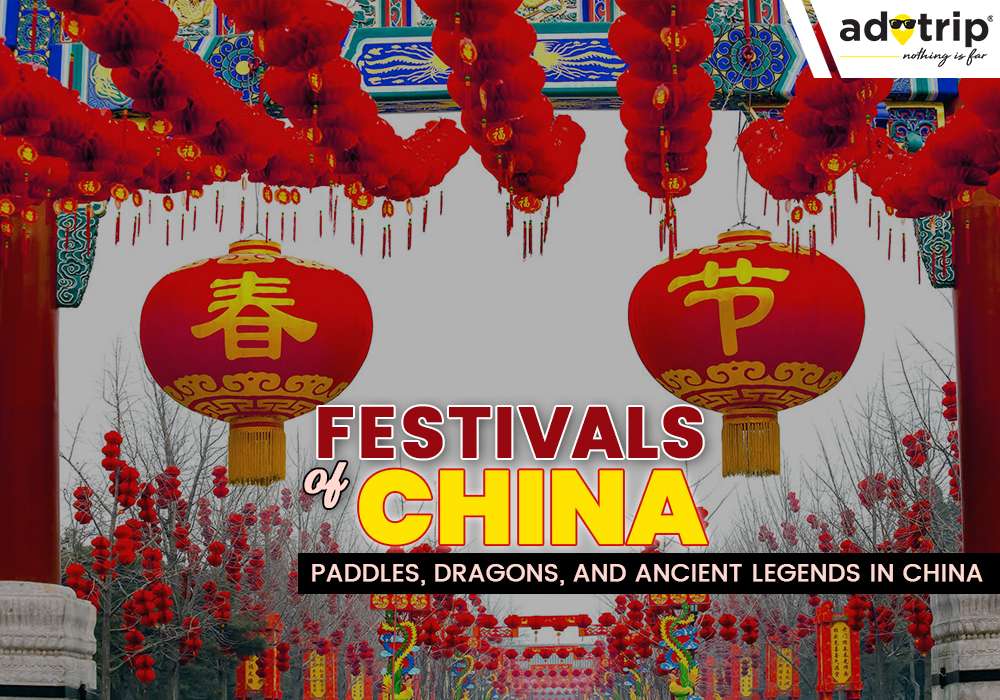
Last Updated At: 09-May-2024
Culture of China - Traditions, Food, Dance, Music
Nestled within the vast landscapes of China lies a cultural mosaic that stretches back thousands of years, a tapestry woven with threads of tradition, philosophy, artistry, and innovation. From the majestic peaks of the Himalayas to the bustling streets of its modern cities, China's rich cultural history is a multifaceted gem that reflects the depth of its history and the dynamism of its present. In this exploration, we embark on a captivating journey to delve into the heart of China's cultural heritage, peeling back the layers to reveal the essence of a civilisation that has profoundly shaped the world.
Traditional customs of China are a journey through time, marked by the rise and fall of dynasties, the evolution of artistic expressions, and the convergence of philosophies that have left indelible marks on humanity's collective consciousness. This intricate tapestry is woven from the threads of Confucianism, Daoism, and Buddhism, with detailed calligraphy strokes, mesmerising traditional music, and the scent of incense wafting through ancient temples. It's a fusion of ancient wisdom and modern aspirations, a dichotomy characterising a nation in constant dialogue with its past while forging ahead into the future.
Traditions, Art, Culture of China
As we journey into the culture of China, we uncover a society that blends the ancient with the contemporary, a nation that embraces its heritage while embracing the global exchange of ideas. From the delicate intricacies of Chinese porcelain to the bold brushstrokes of calligraphy, from the tantalising flavours of regional cuisine to the soaring melodies of traditional music, cultural practices in China beckons us to explore its nuances, to appreciate its complexities, and to marvel at its enduring influence on the world stage.
- Historical Background and Dynastic Legacy | Unveiling China's Dynastic Legacy
- Calligraphy and Brushwork | The World of Chinese Calligraphy
- Chinese Opera and Theater | Beyond the Curtains
- Traditional Music and Instruments | Exploring Traditional Chinese Music
- The Great Wall of China | Discovering the Great Wall's Legacy
- Temples and Religious Sites | Sacred Journeys
- Traditional Chinese Medicine and Wellness | Navigating Traditional Chinese Medicine
- Contemporary Arts and Innovations | Contemporary Visions in Chinese Culture
- Chinese Literature and Poetry | Exploring Chinese Literature
- Modern Chinese Cinema and Film Industry | Unmasking Modern Chinese Cinema
1. Historical Background and Dynastic Legacy | Unveiling China's Dynastic Legacy
China's history is a captivating saga of rising and falling dynasties, leaving behind a profound legacy that shapes the nation's identity. Each era brings a tapestry of traditions, ideologies, and technological advances, from the Shang Dynasty's oracle bones to the mighty Qing Dynasty. The dynastic cycle of rise and decline, imperial power struggles, and cultural achievements have collectively sculpted today's China. By uncovering the historical intricacies, we gain insight into how dynasties contributed to the nation's cultural foundation and how their legacies continue to influence contemporary China.
2. Calligraphy and Brushwork | The World of Chinese Calligraphy
Calligraphy in China is more than a form of writing; it's an art that embodies the essence of Chinese culture. With every brushstroke, calligraphy captures movement, rhythm, and emotion. From the graceful curves of cursive script to the disciplined structure of seal script, each style tells a unique story. Calligraphy transcends mere communication, serving as a bridge between the tangible and spiritual, expressing the scribe's inner self. Exploring the world of Chinese calligraphy unravels its profound symbolism, aesthetic nuances, and role as a treasured cultural heritage.
3. Chinese Opera and Theater | Beyond the Curtains
Chinese opera is a captivating spectacle harmoniously weaves music, dance, drama, and storytelling. From the intricate makeup of Peking opera to the graceful movements of Kunqu, each genre carries centuries of tradition. Beyond the ornate costumes and vibrant performances, Chinese opera reflects the nation's historical narratives, folklore, and societal values. This art form provides a window into cultural expressions, emotions, and societal commentary, offering an immersive experience that unites the past and the present.
4. Traditional Music and Instruments | Exploring Traditional Chinese Music
The melodies of traditional Chinese music resonate with centuries of history and cultural diversity. From the ethereal notes of the guqin to the exuberant tunes of the erhu, each instrument carries a unique voice. This exploration of traditional music delves into its genres, regional variations, and role in ceremonies, celebrations, and daily life. By understanding the essence of these musical forms, we gain insight into China's diverse regions, artistic heritage, and the emotional depth that music brings to its culture.
5. The Great Wall of China | Discovering the Great Wall's Legacy
The Great Wall of China is a testament to human ambition and perseverance. Spanning thousands of miles, it is both a physical marvel and a cultural icon. Beyond its architectural brilliance, the Great Wall embodies historical narratives of defence, unity, and cultural exchange. Traversing its stones reveals the stories of soldiers, engineers, and emperors who contributed to its construction. Unveiling its legacy illuminates its significance as a guardian of history, a symbol of China's strength, and a testament to the enduring impact of human endeavour.
6. Temples and Religious Sites | Sacred Journeys
China's landscape is adorned with temples and religious sites that reflect the nation's diverse spiritual beliefs. Each temple carries unique architectural styles, symbols, and practices associated with Buddhism, Daoism, Confucianism, and other traditions. These sacred spaces invite individuals on spiritual journeys, offering a glimpse into China's rich religious heritage, values, and philosophies. From the serene interiors to the bustling courtyards, temples serve as a conduit between the earthly and the divine, bridging cultural continuity and spiritual reverence.
Also Read: Festivals of China
7. Traditional Chinese Medicine and Wellness | Navigating Traditional Chinese Medicine
Traditional Chinese Medicine (TCM) is a holistic approach to wellness that emphasises harmony between the body and the natural world. This exploration into TCM reveals its principles of qi, yin and yang and the interconnectedness of the body's energies. With acupuncture, herbal remedies, and mindful practices, TCM seeks to restore balance and promote well-being. Rooted in ancient philosophies, TCM reflects China's deep understanding of the body's rhythms and the importance of living in harmony with nature.
8. Contemporary Arts and Innovations | Contemporary Visions in Chinese Culture
Amidst modernisation, China's contemporary arts and innovations create a dynamic fusion of tradition and innovation. This exploration delves into the world of modern Chinese art exhibitions, digital creations, and cutting-edge technological advancements. Artists and innovators bridge the gap between centuries-old traditions and global contemporary expressions. From gallery exhibitions to interactive installations, these contemporary visions reflect China's evolving society, creative spirit, and the quest to find meaning in a rapidly changing world.
9. Chinese Literature and Poetry | Exploring Chinese Literature
Chinese literature is a treasure trove of narratives that span centuries, capturing the essence of China's societal, emotional, and philosophical landscape. From classical works like "Journey to the West" to modern masterpieces, literature reflects changing worldviews, societal challenges, and timeless themes. This exploration into Chinese literature navigates through prose, poetry, and storytelling traditions that offer a window into the nation's soul, traversing eras and genres to connect the past and the present.
10. Modern Chinese Cinema and Film Industry | Unmasking Modern Chinese Cinema
China's film industry has transformed from its early days into a global cinematic force. This exploration delves into the evolution of modern Chinese cinema, uncovering its thematic richness, cinematic innovations, and role as a cultural ambassador on the global stage. From historical epics to contemporary dramas, Chinese cinema provides insights into the nation's complex narrative, offering a cinematic lens to understand its society, values, and aspirations.
The culture of China stands as a mesmerising tapestry woven from centuries of rich history, diverse traditions, and profound philosophies. Its legacy is an intricate blend of ancient wisdom and modern innovation, seamlessly fusing traditional values with contemporary aspirations. From its iconic landmarks to its artistic expressions, culinary delights, and spiritual practices, China's culture is a testament to the resilience and adaptability of a nation that has thrived through millennia. The cultural landscape of China is a living testament to the unity that emerges from its diversity. It reflects the harmonious coexistence of various ethnicities, languages, and belief systems, showcasing the enduring power of tolerance and mutual respect. China's cultural heritage has left an indelible mark on the world, shaping global perceptions and influencing various aspects of human civilisation. So get ready to immerse yourself in this rich cultural journey to China with Adotrip, and enjoy a hassle-free trip.
With us, nothing is far!
Book China tour packages
Frequently Asked Questions about the Culture of China
Q1. How important is Confucianism in Chinese culture?
A1. Confucianism holds significant importance in Chinese culture as a foundational philosophy that has influenced social norms, ethics, and values for centuries.
Q2. What role does Chinese cuisine play in culture?
A2. Chinese cuisine plays a crucial role in culture by:
- Reflecting Regional Diversity
- Celebrating Festivals and Traditions
- Symbolising Harmony and Balance
- Fostering Social Interaction
- Preserving Culinary Heritage
Q3. How has calligraphy become a revered art form?
A3. Calligraphy has become a revered art form due to the following:
- Deep Historical Roots
- Cultural Significance and Symbolism
- Mastery of Techniques and Styles
- Expression of Individuality
- Connection to Philosophical Ideas
Q4. What folk tales like Journey to the West shape culture?
A4. Folk tales like "Journey to the West" shape Chinese culture by:
- Transmitting Moral Lessons
- Portraying Cultural Values
- Reflecting Historical Context
- Inspiring Artistic Creations
- Bonding Generations Through Storytelling
Q5. How integral are concepts like yin/yang and feng shui?
A5. Concepts like yin/yang and feng shui are integral in Chinese culture by:
- Balancing Opposites (yin/yang)
- Guiding Lifestyle and Health (yin/yang)
- Harmonizing Spaces (feng shui)
- Influencing Architecture and Design (feng shui)
- Reflecting Holistic Worldview (yin/yang and feng shui)
Q6. What major dynasties influenced development?
A6. Major dynasties that influenced China's development include:
- Qin Dynasty: Unified China and established an imperial system.
- Han Dynasty: Expanded territory and promoted Confucianism.
- Tang Dynasty: Flourished culturally and connected with the Silk Road.
- Song Dynasty: Innovations in art, science, and governance.
- Ming Dynasty: Cultural revival and maritime exploration.
Q7. How did Mao and communism change culture?
A7. Mao and communism changed Chinese culture by:
- Cultural Revolution: Attempt to eradicate traditional values.
- State Control: Regulated arts, media, and education.
- Collectivist Ideals: Emphasised unity over individuality.
- Social Transformation: Shifted gender roles and rural-urban dynamics.
- Promotion of Marxism: Integrated ideology into education and society.
Q8. What spiritual and philosophical traditions persist?
A8. Spiritual and philosophical traditions persist in China through:
- Buddhism: Influential since ancient times.
- Daoism (Taoism): Embracing harmony and natural principles.
- Confucianism: Shaping ethics and social norms.
- Folk Religions: Ancestral worship and local traditions.
- Syncretism: Blending multiple beliefs in daily life.
Q9. What role do cities like Beijing play as cultural hubs?
A9. Cities like Beijing play as cultural hubs by:
- Historical Significance: Preserving ancient architecture and landmarks.
- Cultural Institutions: Hosting museums, theatres, and art galleries.
- Political Centre: Symbolising national identity and governance.
- Educational Centers: Housing renowned universities and research centres.
- Tourist Attractions: Showcasing diverse traditions, festivals, and heritage.
Q10.How do Chinese values prioritise family and education?
A10. Chinese values prioritise family and education:
- Filial Piety: Respecting and caring for elders.
- Ancestor Worship: Honouring family lineage.
- Confucian Values: Emphasising education and moral development.
- Scholarly Achievement: Valuing academic success.
- Interdependence: Fostering family unity and support.
--- Published By Adotrip
Latest Blogs

Long Weekends In India 2025 - List of Holidays

Kazakhstan Travel Guide 2025: Affordable Luxury, Visa Free E...

Think Ayodhya is Just Temples? Discover Its Hidden Artistic...

Why Azerbaijan is the Best Budget Friendly Alternative to Sw...











 (1).png)
 Dubai
Dubai Malaysia
Malaysia USA
USA





